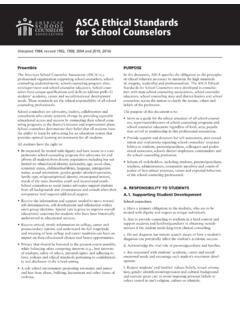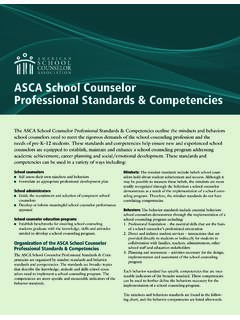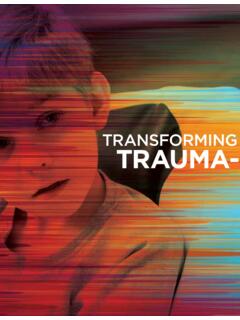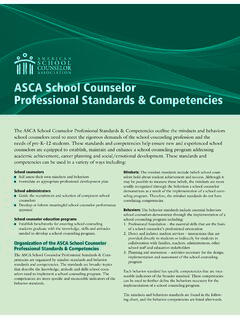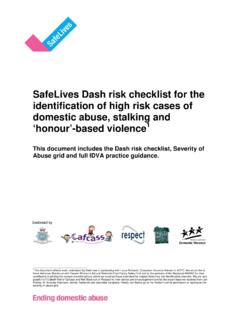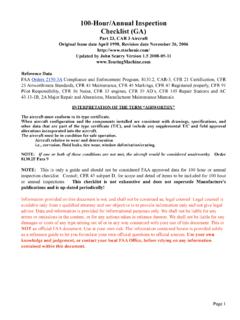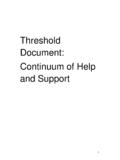Transcription of Evidence-based school counseling curricula for elementary ...
1 10/24/2016. Learning Outcomes: Upon completion of this webinar, participants should be able to: Evidence-based 1. Identify a variety of student data to use for determining school counseling program and intervention priorities. curricula for 2. Implement elementary -level school counseling elementary school interventions that have evidence of efficacy. 3. List benefits of using data-driven approaches and Counselors choosing Evidence-based interventions. 4. Explain a variety of strategies for disseminating results October 24, 2016 of interventions to administrators, parents, school Presenters: Brett Zyromski, , Melissa Mariani, board members and other educational stakeholders.
2 , and Carey Dimmitt, Evidence-based school counseling (EBSC). A Model and Process for Evidence-based school counseling Dimmitt, Carey and Hatch (2007) define evidence- Dimmitt, C., Carey, J., & Hatch, T. Zyromski, B., & Mariani, M. A. based school counseling as the intentional use of the (2007). Evidence-based school (2016). Facilitating Evidence-based , data-driven school counseling : A. best available evidence in planning, implementing, and counseling : Making a difference with data-driven practices. manual for practice. Thousand evaluating school counseling interventions and Thousand Oaks, CA: Corwin.
3 Oaks, CA: Corwin. programs (p. ix). It is inferred, therefore, that school counselors (a) know what to prioritize what really needs to be addressed, (b) can identify what is likely to work to meet that need and (c) have the skills to evaluate if the intervention made a difference. Evidence-based school counseling The EBSC Process Model: A Review Either continue using Intervention Outcome something that is A) Assess/re-assess the needs of the students and the barriers Evaluation Research being successful or blocking their success (Data-Driven Decision Making) how Evaluate your choose an intervention Evidence- do you do this now?
4 Intervention Based that the research and evolve Practice suggests works with a B) Either continue using something that is being successful or similar population to choose an intervention that the research suggests works with Data- remove the barrier(s). Driven to success a similar population to yours to remove the barrier(s) to Decision success (Using Outcome Research/ Evidence-based Making Interventions) are you targeted? Assess/re-assess the C) Evaluate your intervention and evolve (Evaluation) how do needs of the students and you collect data to support your interventions and services the barriers blocking their success and if so, what types?
5 Dimmitt, Carey &Hatch, 2007. and Zyromski & Mariani, 2016. 1. 10/24/2016. Natural Consequences of EBSC Critical Components! 1. Prioritization of SC time occurs 1. The needs of the students 2. Equity gaps are closed must be accurately assessed 3. Program goals are set and their voices must be 4. SC job roles change and evolve to meet included student needs 5. Interventions evolve based on results 2. Interventions must be driven by student needs, not adult preferences 3. Evaluation of intervention results is vital Evidence-based school counseling Either continue using Step 1: Assessing Intervention Outcome Research something that is being successful or Evaluation Student needs through Evaluate your intervention Evidence- choose an intervention that the research Based the Use of data and evolve Practice suggests works with a similar population to Data- remove the barrier(s).
6 Driven to success Decision Making Assess/re-assess the needs of the students and the barriers blocking their success Dimmitt, Carey &Hatch, 2007. and Zyromski & Mariani, 2016. Accurate Assessment of Student Needs and Data Indicators Accurate assessment of student issues is gathered through: needs assessments Step 2: Using the use of student data focus groups Outcome research to meetings with teachers/parents/students identify evidence- THEN we can match our interventions to the students'. needs based interventions . Key Questions: Which interventions should we use to meet our students'.
7 For your students needs? Which have been proven to work with a similar population? 2. 10/24/2016. Evidence-based school counseling Matching Interventions to Needs Often, adults attempt to match Either continue using interventions to goals instead of Intervention Outcome something that is matching interventions to needs. Evaluation Research being successful or Evaluate your choose an intervention Evidence- intervention Based that the research Goals are often adult driven . and evolve Practice suggests works with a interventions are student-driven similar population to Data- remove the barrier(s).
8 Driven What are students saying are the to success Decision barriers to success? Making Assess/re-assess the How well we address student needs of the students and needs or support student the barriers blocking their strengths will directly correlate success with how quickly our data Dimmitt, Carey &Hatch, 2007. and Zyromski & Mariani, 2016 changes. CASEL Guide - elementary EB SEL ( ). Where Do We Find Evidence-based Interventions? Outcome Research Resources What Works Clearinghouse: SAMHSA National Registry of Evidence-based Programs and Practices: Collaborative for Academic, Social and Emotional Learning (CASEL): Centers for Disease Control and Prevention (CDC/DASH): Fredrickson Center for school counseling Outcome Research and Evaluation (CSCORE).
9 Resources for school Counselors page: RTI Levels of Intervention Model Tier 1 school -Wide Interventions: Tier 3 Services across tiers are Integrated Academic and Social Few Students (5-10%). Reduce severity, intensity and complications of existing Intense, fluid and data-driven Emotional Skill Development Individualized District/Community Team problems Tier 2. Support Student Services Team Student Success Skills (PreK-12). At-Risk Students (10-20%). Small Group Targeted, Supplemental Supports Student Services Team 4Rs (PreK-8). Reduce current problems Tier I Evidence-based Caring school Community (K-6).
10 Grade Level Teams Practices &. All Students (100%). Reduce new Interventions Student Services Team school Improvement Team Positive Action (PreK-12). problems Preventative, Core Curriculum, Instruction, and Learning Responsive Classroom (K-6). Proactive Environment school -wide Positive Behavioral Interventions and Supports (K-12). 3. 10/24/2016. Student Success Skills Curriculum is a three part PK-12 model Four Foundational Learning Skills Paying Attention Ready to Learn (RTL) PreK 1st grade Listening and Understanding Ready for Success (RFS) 2nd 3rd grade Asking Effective Questions Student Success Skills (SSS) 4th 12th grade Encouragement Three Keys to Building Resilience Delivery Time and Cost and Reducing school Failure RTL Classroom Program 5, 30-minute lessons daily or weekly with follow up activities Skills.

